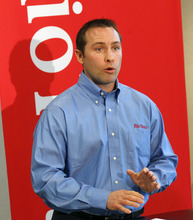This is an archived article that was published on sltrib.com in 2013, and information in the article may be outdated. It is provided only for personal research purposes and may not be reprinted.
No closer to answers but still coping with the impact, Kennecott Utah Copper said Monday it is asking its 800 mine employees to voluntarily take accrued vacation or unpaid time off as the company deals with the massive landslide at its Bingham Canyon Mine.
The unusual request isn't mandatory, and any mine employee who wants to continue to stay on the job will be provided work in other areas of the operation, at least for the time being, said Kennecott spokesman Kyle Bennett. "They may be asked to perform duties that aren't consistent with their regular roles, but they will be given work."
Bennett said as of Monday, all employees were being asked to report to work as usual.
As they do, some are feeling a little uneasy, said Wayne Holland, international staff representative for the United Steelworkers of America, which represent about 1,500 Kennecott workers. He noted that a number of the mine's 800 or so employees were concerned about being put into unfamiliar jobs.
"It is something that we'll be talking to the company about," he said. "But I don't imagine that Kennecott will be putting anyone into any position where their existing safety training wouldn't apply."
The massive landslide hit Kennecott's open-pit copper mine Wednesday night along the northeast wall. Although the slide was anticipated and all employees were evacuated ahead of time, its size and scope were much larger than expected. In the days since, the company has endeavored to get a handle on such key issues as whether conditions inside the mine have stabilized, how soon it might be safe to closely examine the affected section and when mining operations might resume.
On Monday, Bennett said the company remained in discussions with the U.S. Mine Safety and Health Administration (MSHA) about gaining clearance to access the slide area and determine what its next steps need to be to return the mine to production.
Holland said Monday night that representatives from the union and Kennecott met in the evening to discuss employment issues after the collapse, including workers' safety as they move back in and the company's request for voluntary time off. Holland said that the union hoped to avoid the possibility of furloughs or layoffs in the near future.
"We had a good discussion about that," Holland said.
He said both parties are waiting for the results of the MSHA investigation to determine how to move forward.
"I think in the next few days, we'll know a whole lot more," Holland said.
In media reports last week, one employee said he'd heard it might take two years to clean up the slide, but Bennett termed that "speculation" and said no determinations has been made.
During the weekend, Kennecott was able to return about 350 employees to work on the southeast wall of the mine, which is one of the largest open-pit operations in the world. Those workers are removing "overburden" (or waste rock) to get at new sources of ore that are the target of the copper mine's "Cornerstone" project. In that effort, Kennecott aims to push back the mine's south wall by about 1,000 feet so miners can eventually deepen the massive pit by another 300 feet and reach an additional 700 million tons of copper ore.
On Monday, Bennett said Kennecott also had temporarily closed its "concentrator" for regularly scheduled maintenance not associated with the slide.
The concentrator represents the second step in Kennecott's production process. It takes crushed ore and mixes it into a slurry that is then piped to flotation cells where it is mixed with reagents to produce a bubbly froth. Copper, gold, silver and other metals adhere to the bubbles, which float over the sides of the flotation cells. Kennecott then collects and filters that material, which is called concentrate.
The concentrate, which contains about 26 percent copper and by-products such as gold and silver, is then sent through a pipeline to the company's smelter for further processing.
Kennecott said it had enough stockpiled ore and concentrate on hand to continue to produce refined copper for several weeks.
Tribune reporter Kimball Bennion contributed to this article.



